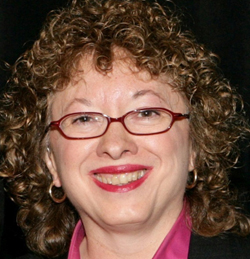That company — based on a patent Oberle developed while at Engelhard for a process to make high volumes of flexible, electronic circuits specifically for RFID (radio frequency identification) applications — did fine up to a point. But because of changes in the market, the team decided to dissolve RCD Technology and launch a new company, Vizinex RFID, specializing in building durable RFID tags.
Since its founding in 2012, Vizinex has experienced a growth pattern of 40 percent nearly every year. Their customers — mostly in the rental equipment, oil and gas equipment, medical device and IT equipment industries — are located all over the United States.
As demand for this technology grows, Oberle expects the company to continue to grow along with it.
Originally from the Washington, D.C. area, Oberle is a graduate of the Rensselaer Polytechnic Institute, where he majored in physics; he also earned a master’s degree and doctorate from Johns Hopkins University in material science and engineering.
What inspired you to found Vizinex RFID?
Over time, the manufacture of high-volume, low-cost RFID products became so large-volume that this became attractive to companies that had offshore facilities and economies of scale and lots of capital. So the original business model of RCD Technologies became untenable.
When we were still RCD, we had started developing a business of building durable asset tags.
There was a need for this — the types of RFID tags that were available at the time didn’t address some of the needs of the expanding market. For example, if you wanted to do inventory of assets made of metal, the flexible RFID tags didn’t work on metal surfaces. That was a significant unmet need. At that time, people, including us, were working on how to make an RFID tag that would work on metal.
We came up with a design, now patented, for a 3-D antenna that allows an RFID tag to work very well on a metal surface. And it’s in a compact format, so it allows the tag to be small and have a very big read range.
Other people have come up with solutions to the same problem, but we think ours is better, and we do a good job in our market space.
We also have worked on durability. If the RFID tag is a paper label, you can’t have it outside for years, you can’t handle it in an industrial environment where it might get banged, and you can’t heat it to high temperatures.
The product base and materials of manufacturing we use lend themselves to high durability, high-temperature stability, etc., while allowing us to address the first hurdle, which was to make a tag that works on a metal surface.
Because some of the tags are used in the client’s manufacturing process of products, that’s good business for us because we can make a tag that does exactly what the customer needs it to do.
Meanwhile, there’s still a significant retrofit requirement. An example of this might be data centers, where there are many computers and disk drives and other equipment. While we sell tags that go into OEM manufacturing of some of the computer servers, the data centers also own some [technology] that comes from other manufacturers who don’t incorporate the tags in their process. The data centers, when doing inventory, need to put the tags on everything, so we sell tags that are applied in the field.
How did you get your original business started in 2001?
We went to Ben Franklin Technology Partners of Northeastern Pennsylvania (BFTP/NEP) for assistance, and started the company in their technology incubator at Lehigh University (that would later evolve into TechVentures) in Bethlehem. At the time, it was across the road in Jordan Hall. We started the company in 2001 and moved in in 2002.
We worked in collaboration with BFTP/NEP to build up the technology and commercialize it.
In 2006, we moved to a 12,000-square-foot facility in Quakertown, where we stayed until 2012.
We still talk with the people at Ben Franklin on an ad hoc basis; they’re a great resource.
Why did you choose to start your business in the Lehigh Valley?
At the time, we lived in New Jersey. Pennsylvania was a much more attractive place to start a business. BFTP/NEP was very helpful and the taxes here are much lower. At the time in New Jersey, if you weren’t pharma or biomedical, nobody really cared.
How has Vizinex RFID grown since its founding?
In 2012, we moved to our current, smaller facility in Allentown, since we now do more compact manufacturing. Our workforce has grown to 12 people (a mix of full-time and contract).
Our customer base has grown in the number of customers and in the diversity of applications in which we’re incorporating tags. The revenues have grown significantly: Year-over-year, they have grown by about 40 percent each year.
When we moved here, the product was in a market space that had really grown. We thought it would continue to grow, and happily we were correct. We have approximately 50 to 70 regular clients, and of those, the top 10 account for the greatest part of our sales.
About 90 percent of our business is in the U.S. We have large customers in California, Texas and Minnesota. Because we focus on medical devices and IT equipment, most of the customers are not local.
Do you do all your own manufacturing?
No. We do all the design and product validation in Allentown, as well as assembly of the radio-frequency component. We also sell products that require operations beyond our capabilities. For instance, we make a product that is encapsulated in plastic. We don’t do the overmolding here. We assemble the electronic components, then send it to a partner company for overmolding; then we do the testing here and ship it to the customer. There are several products like that.
What has been the biggest challenge in getting the company off the ground?
Being recognized in the market, because we’re a small company. You have to grow a brand, and you don’t have huge resources to put into advertising. We’ve been successful working with Altitude Marketing, people in selected verticals, with our web marketing and targeted advertising.
What’s the big differentiator for Vizinex RFID?
While we’re not a huge company, we’re very good at what we do, we deliver, and we’re not beholden to a long supply chain that goes back to China. So we can be very nimble in terms of serving our customers’ needs.
We’ve been told by customers that the ROI (return on investment) is as little as six months. When they see the streamlining of the inventory or manufacturing process, they’re really happy about it.
What’s next for Vizinex RFID?
We think we’re on a good growth path in terms of serving the customers we have, keeping them with us, and acquiring new ones. As RFID has become something that really is a business (four or five years ago it was still considered pretty nascent and developing) and has real applications, we think people will recognize that this is an identification technology they can use and they will find ways to implement it.
Writer: Susan L. Pena

↑ Top


